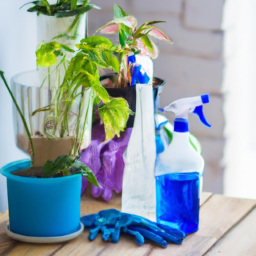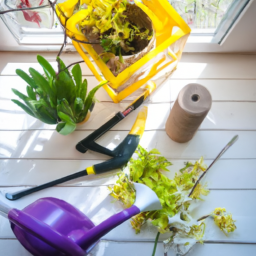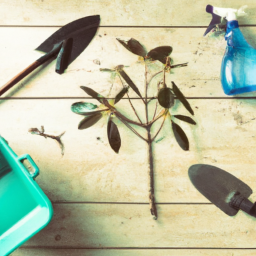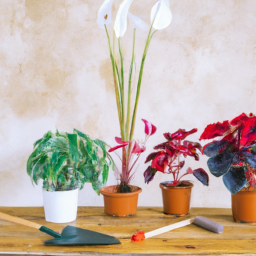
Spring Cleaning for Plants: Revive Your Space
As the days grow longer and the weather starts to warm up, it’s the perfect time to give your plants some much-needed attention. Just like our homes, our plants can benefit from a little spring cleaning too. Whether you’re a seasoned plant parent or just starting out, taking the time to refresh and revive your space can make a world of difference for both you and your leafy friends. In this blog post, we’ll explore some simple yet effective ways to spruce up your indoor and outdoor plants, ensuring they thrive and bring life to your surroundings. So grab your gardening gloves and let’s dive into the world of spring cleaning for plants!
Importance of Spring Cleaning for Plants: Enhancing the Health and Aesthetics of Your Indoor Garden
Spring cleaning is not just for your home; it’s also essential for your indoor plants. After a long winter, your plants may be in need of some extra care and attention to revive their health and enhance the aesthetics of your indoor garden. In this guide, we will take you through the step-by-step process of spring cleaning for plants, ensuring that you create a fresh and vibrant atmosphere in your space.
Assessing the Health of Your Plants
Before diving into the cleaning process, it’s crucial to assess the health of your plants. Look for any signs of distress, such as yellowing leaves, wilting, or pest infestations. Identify any specific issues that need to be addressed, as this will guide your cleaning and maintenance efforts.
Start by examining the leaves of your plants. If you notice any discoloration or spots, it could be a sign of disease or nutrient deficiencies. Take note of these observations and plan your cleaning process accordingly.
Next, check the soil moisture levels. Overwatering or underwatering can both be detrimental to plant health. Stick your finger about an inch into the soil to determine its moisture content. If it feels dry, it’s time to water your plants. If it feels excessively wet, consider adjusting your watering routine or improving drainage.
Cleaning the Leaves
One of the most crucial steps in spring cleaning for plants is cleaning the leaves. Dust, dirt, and debris can accumulate on the surface of the leaves, blocking sunlight and hindering photosynthesis. Here’s how you can effectively clean the leaves:
1. Fill a spray bottle with lukewarm water.
2. Gently mist the leaves, ensuring that the water reaches both sides of the foliage.
3. Take a soft, damp cloth and wipe the leaves gently to remove any remaining dirt or dust.
For larger plants or those with hard-to-reach leaves, you can also use a handheld shower attachment or place them in the shower for a gentle rinse. Remember to avoid using any harsh chemicals or cleaners, as they can damage the leaves and harm your plants.
Pruning and Trimming
Spring is an excellent time to prune and trim your plants to promote healthy growth and maintain their shape. Follow these steps to effectively prune and trim your indoor plants:
1. Start by removing any dead or yellowing leaves. These leaves not only detract from the overall aesthetics of your indoor garden but can also attract pests and diseases.
2. Use clean, sharp pruning shears to trim any overgrown branches or stems. Cut just above a leaf node or bud to encourage new growth.
3. If you have vining plants, consider providing them with support, such as a trellis or stake, to help them grow upright.
Regular pruning and trimming not only keep your plants looking neat and tidy but also prevent overcrowding and improve air circulation, reducing the risk of fungal diseases.
Repotting and Soil Refresh
Over time, indoor plants can outgrow their pots, leading to root-bound conditions. Spring is an ideal time to repot your plants and refresh their soil to provide them with the necessary nutrients and space for healthy growth. Here’s how you can do it:
1. Choose a pot that is one size larger than the current one. Ensure that it has drainage holes to prevent waterlogging.
2. Carefully remove the plant from its current pot, gently loosening the roots if they are tightly bound.
3. Place a layer of fresh potting soil at the bottom of the new pot.
4. Position the plant in the center of the pot and fill the remaining space with fresh potting soil, gently pressing it down to eliminate air pockets.
5. Water the plant thoroughly to settle the soil.
Repotting allows your plants to access fresh nutrients and encourages healthy root development. Additionally, refreshing the soil helps improve drainage and prevents the buildup of salts and minerals that can be harmful to your plants.
Maintaining a Healthy Environment
Once you have completed the spring cleaning process for your plants, it’s essential to maintain a healthy environment to ensure their continued well-being. Here are some tips:
1. Provide adequate sunlight: Most indoor plants thrive in bright, indirect light. Place them near windows or provide artificial grow lights if natural light is limited.
2. Monitor watering: Avoid overwatering or underwatering your plants. Stick to a consistent watering schedule and adjust it based on the specific needs of each plant.
3. Check for pests: Regularly inspect your plants for any signs of pests, such as webs, tiny insects, or chewed leaves. If you notice any, take immediate action to prevent an infestation.
4. Fertilize appropriately: Feed your plants with a balanced, water-soluble fertilizer during the growing season to provide them with essential nutrients.
By following these maintenance practices, you can ensure that your indoor garden remains vibrant, healthy, and visually appealing throughout the year.

Essential Steps for Reviving Your Space: Tips and Tricks for Spring Cleaning Your Indoor Plants
Spring is the perfect time to give your indoor plants some much-needed attention and care. As the days get longer and the weather warms up, your plants will start to come back to life. To help them thrive, it’s important to give them a thorough spring cleaning. In this article, we will guide you through the essential steps to revive your space and ensure your indoor plants stay healthy and vibrant.
Step 1: Assess the Health of Your Plants
The first step in spring cleaning your indoor plants is to assess their overall health. Take a close look at each plant and check for any signs of disease, pests, or damage. Look for yellowing or browning leaves, wilting, or spots on the foliage. If you notice any issues, take note of them and make a plan to address them later.
Next, check the soil moisture levels of your plants. Stick your finger about an inch into the soil to see if it feels dry or moist. Overwatering or underwatering can lead to root rot or dehydration, so make sure to adjust your watering routine accordingly.
Additionally, evaluate the size of your plants and determine if they need to be repotted. If the roots are overcrowded or growing out of the drainage holes, it’s time to give them a larger pot to thrive in.
Step 2: Clean the Leaves
One of the most important steps in spring cleaning your indoor plants is to clean their leaves. Dust and debris can accumulate on the foliage, blocking sunlight and hindering photosynthesis. This can lead to a dull appearance and stunted growth.
To clean the leaves, fill a spray bottle with lukewarm water and add a few drops of mild dish soap. Spray the soapy water onto a clean, soft cloth and gently wipe the leaves, paying extra attention to the undersides where pests like to hide. Alternatively, you can use a damp sponge or a soft brush to remove the dust. Be sure to avoid using any harsh chemicals or abrasive materials that can damage the leaves.
For plants with large or delicate leaves, such as ferns or orchids, you can also place them in the shower and give them a gentle rinse with lukewarm water. This will help remove any stubborn dirt or dust particles.
Step 3: Prune and Trim
Pruning and trimming your indoor plants is an essential step in their spring cleaning process. It helps remove dead or dying foliage, promotes new growth, and maintains the overall shape and appearance of the plants.
Start by using clean, sharp pruning shears to cut off any yellowed, browned, or damaged leaves. Make sure to sterilize the shears with rubbing alcohol before and after each use to prevent the spread of diseases.
Next, trim any overgrown branches or stems to encourage bushier growth. Look for any leggy or straggly growth and cut it back to a node or leaf joint. This will redirect the plant’s energy to healthier areas and promote a more compact and attractive shape.
Remember to step back and assess the overall appearance of your plants as you prune. Don’t be afraid to experiment and shape them according to your preference, but always keep in mind the specific needs and growth habits of each plant.
Step 4: Repotting and Soil Refresh
If you’ve determined that your plants need repotting, spring is the perfect time to do it. Repotting provides your plants with fresh nutrients and allows their roots to grow freely.
Choose a pot that is slightly larger than the current one and has drainage holes to prevent waterlogging. Fill the new pot with a well-draining potting mix suitable for your plant’s specific needs. Gently remove the plant from its old pot, loosen the roots, and place it in the new pot. Fill the gaps with fresh potting mix, ensuring that the plant is stable and upright.
While repotting, take the opportunity to refresh the soil of your existing potted plants as well. Remove the top layer of soil and replace it with fresh potting mix. This will help improve drainage and prevent the buildup of harmful salts and minerals.
After repotting or refreshing the soil, water your plants thoroughly to settle the roots and provide them with the moisture they need to recover.
Step 5: Provide Adequate Light and Water
Once you’ve completed the cleaning, pruning, and repotting process, it’s crucial to provide your indoor plants with the right amount of light and water to help them thrive.
Most indoor plants prefer bright, indirect light. Place them near a window where they can receive filtered sunlight throughout the day. Avoid placing them in direct sunlight, as it can scorch the leaves and cause damage.
Water your plants according to their specific needs. While some plants like to dry out between waterings, others prefer consistently moist soil. Always check the soil moisture levels before watering and adjust accordingly. Remember, overwatering is one of the most common causes of plant problems, so it’s better to underwater than to overwater.
Additionally, consider using a humidifier or placing a tray of water near your plants to increase humidity levels, especially if you live in a dry climate.
By following these essential steps for reviving your space and spring cleaning your indoor plants, you will create a healthier and more vibrant environment for both you and your plants. Enjoy the process and the benefits of having thriving greenery in your home!

Creating a Refreshing Environment: How Spring Cleaning for Plants Can Transform Your Living Space
Welcome to the ultimate guide on spring cleaning for plants! As an expert in this field, I’m here to help you transform your living space into a refreshing environment. Plants not only add beauty and vibrancy to your home but also improve air quality and overall well-being. Let’s dive into the step-by-step process of reviving your space with spring cleaning for plants.
1. Assessing Your Plants’ Health
The first step in your spring cleaning journey is to assess the health of your plants. Take a close look at each plant and check for any signs of distress or disease. Look out for yellowing leaves, wilting, pests, or any other abnormalities. Note down the specific issues you observe for each plant.
Once you have identified the problems, research the appropriate solutions for each issue. This may involve adjusting watering schedules, repotting, pruning, or even consulting with a plant expert. Remember, different plants have different needs, so tailor your approach accordingly.
After addressing the specific problems, it’s time to give your plants a general health boost. Consider applying organic fertilizers or plant food to replenish essential nutrients. This will ensure your plants are ready to thrive in the upcoming season.
2. Cleaning and Repotting
Now that your plants are healthy, it’s time to clean and repot them. Start by gently wiping the leaves with a damp cloth or using a soft brush to remove any dust or dirt. This will not only enhance their appearance but also improve their ability to photosynthesize.
Next, inspect the pots and remove any dead leaves, debris, or excess soil. If a plant has outgrown its current pot, it’s time to repot it into a larger one. Choose a pot that provides adequate drainage and allows room for the roots to grow. Be gentle when transferring the plant to its new home, ensuring you don’t damage the roots.
While repotting, consider refreshing the soil as well. Remove a portion of the old soil and replace it with fresh potting mix. This will provide your plants with the necessary nutrients and improve drainage.
3. Pruning and Trimming
Pruning and trimming are essential steps to maintain the shape and health of your plants. Start by removing any dead or yellowing leaves, as they can attract pests or spread diseases. Use clean and sharp pruning shears to make clean cuts, minimizing the risk of damage.
Trimming can also help promote bushier growth and prevent leggy or lopsided plants. Identify areas where you’d like to encourage new growth and carefully trim the stems or branches accordingly. Remember to research the specific pruning requirements for each plant, as some may have unique needs.
Additionally, consider propagating your plants during the pruning process. This involves taking cuttings from healthy stems and placing them in water or soil to grow new plants. It’s a great way to expand your plant collection and share the joy of gardening with others.
Conclusion
Congratulations! You have successfully completed the spring cleaning process for your plants, and your living space is now transformed into a refreshing environment. By assessing your plants’ health, cleaning and repotting them, and pruning and trimming when necessary, you have set the stage for a thriving indoor garden.
Remember to continue providing your plants with regular care, including appropriate watering, adequate sunlight, and occasional fertilization. With your newfound knowledge and passion for spring cleaning for plants, you can enjoy the benefits of a greener and healthier living space all year round.
Recap of this article
Spring is finally here, and it’s time to give our plants some much-needed love and attention. Just like we clean and declutter our homes, our leafy companions also deserve a little sprucing up. So, let’s roll up our sleeves and embark on a plant spring cleaning adventure to revive our space and breathe new life into our green friends.
First things first, let’s assess the health of our plants. Check for any signs of distress like yellowing leaves, wilting, or pest infestations. Remove any dead or dying foliage and trim back overgrown branches to encourage new growth. Next, it’s time to repot. Gently remove your plant from its current pot, shake off excess soil, and inspect the roots. If they’re tightly packed or circling the pot, it’s time to give your plant a bigger home. Choose a pot that’s one size larger, add fresh potting soil, and carefully transfer your plant, ensuring the roots are spread out evenly. Finally, don’t forget to clean the leaves. Dust and grime can accumulate on the foliage, hindering their ability to photosynthesize. Wipe each leaf gently with a damp cloth or give them a shower under lukewarm water to restore their shine.
Here are some questions from our readers:
Q1: Why is spring cleaning important for plants?
A1: Spring cleaning is important for plants because it helps to rejuvenate and revive their overall health and appearance. During the winter months, plants can accumulate dust, dirt, and debris, which can hinder their growth and make them more susceptible to pests and diseases. By giving your plants a thorough spring cleaning, you can remove any built-up grime, ensure proper air circulation, and promote healthy growth.
Q2: How should I clean the leaves of my plants?
A2: Cleaning the leaves of your plants is essential for their well-being. Start by gently wiping the leaves with a soft, damp cloth or sponge to remove any dust or dirt. For plants with larger leaves, you can also use a gentle spray of lukewarm water to rinse off any residue. Avoid using any harsh chemicals or cleaners, as they can damage the delicate foliage. Regularly cleaning the leaves of your plants will not only enhance their appearance but also allow them to absorb sunlight more effectively.
Q3: What should I do to prepare the soil for spring cleaning?
A3: Preparing the soil is an important step in spring cleaning for plants. Begin by removing any weeds, dead leaves, or debris from the soil surface. Loosen the top layer of soil using a garden fork or a hand cultivator to improve aeration and drainage. If necessary, add organic matter like compost or well-rotted manure to enrich the soil with nutrients. This will provide a healthy foundation for your plants to thrive in the upcoming growing season.
Q4: How often should I water my plants during spring cleaning?
A4: The watering needs of plants can vary depending on their species and environmental conditions. As part of your spring cleaning routine, it’s essential to assess the moisture requirements of each plant individually. Check the soil moisture by inserting your finger about an inch deep into the soil. If it feels dry, it’s time to water. However, be cautious not to overwater, as excessive moisture can lead to root rot. Remember to adjust your watering schedule as the weather conditions change throughout the spring.
Q5: Are there any specific plants that require special attention during spring cleaning?
A5: Yes, some plants may require special attention during spring cleaning. For example, houseplants that have been overwintering indoors may benefit from pruning to remove any leggy or damaged growth. Additionally, plants that have been dormant during the winter, like certain perennials, may need to be divided or transplanted to encourage healthy growth. It’s always a good idea to research the specific care requirements of your plants to ensure they receive the necessary attention during spring cleaning.

James Wong is a renowned ethnobotanist, plant scientist, and local television presenter. With a passion for demystifying plant science, he is known for translating complex botanical concepts into practical advice for everyday plant enthusiasts. James’s expertise spans from traditional gardening to cutting-edge plant technologies, making his insights accessible and informative.


